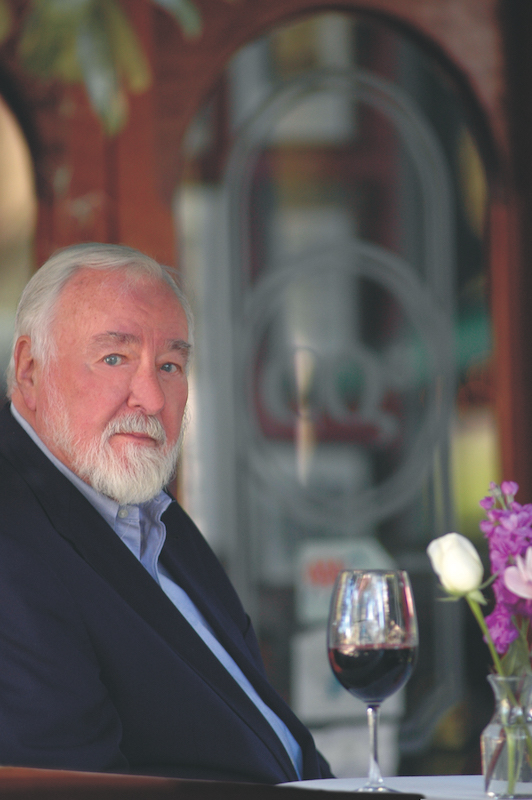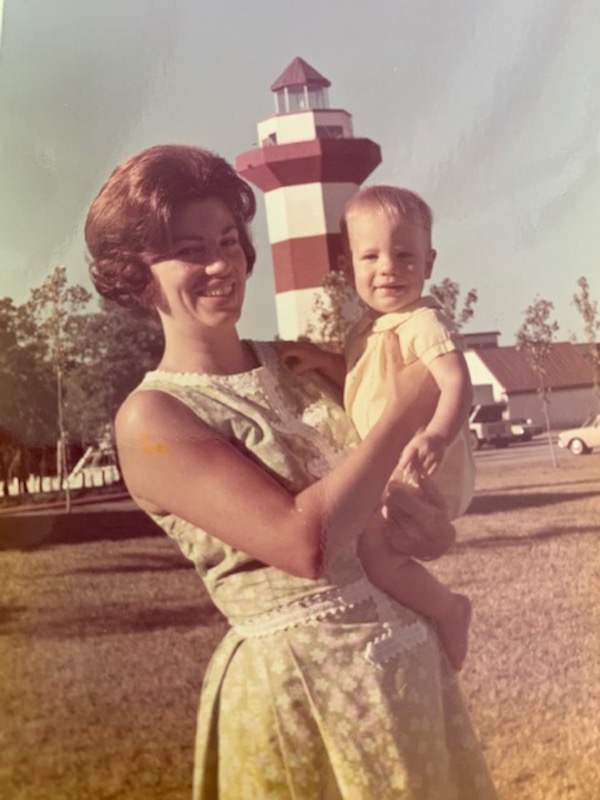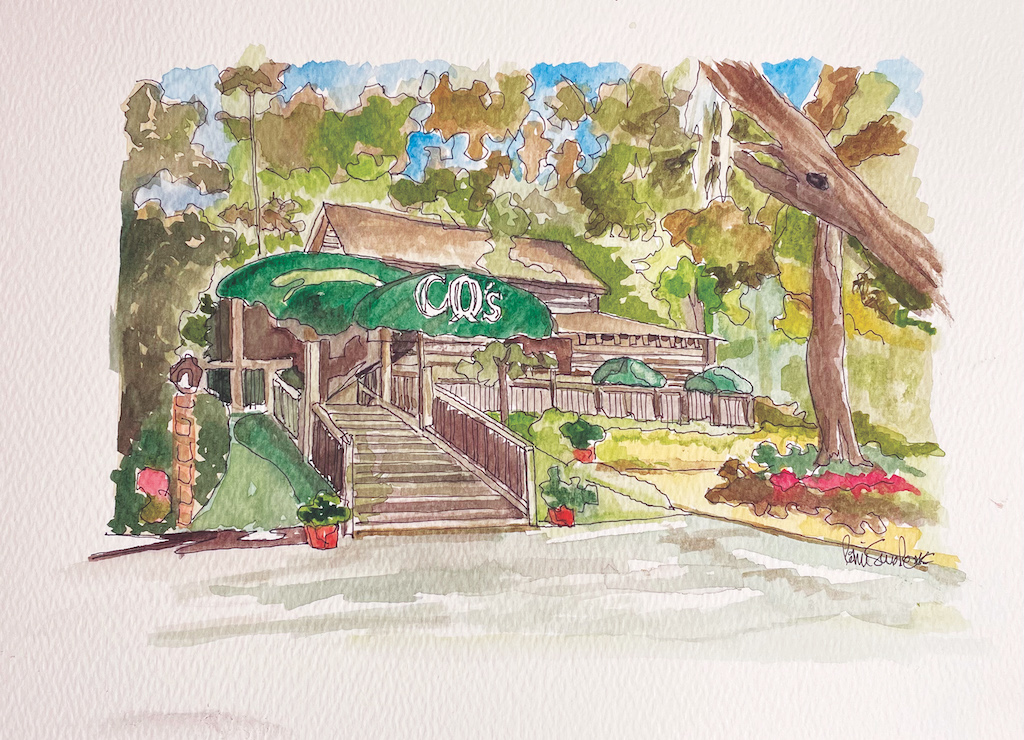When a restaurant is still creating exceptional dining experiences and wonderful guest memories 50 years after first opening its doors, you know they are doing something right.
“Nothing lasts 50 years without a lot of support from many folks,” said Bonnie Lowrey, who has owned CQ’s restaurant in Harbour Town for the past 30 of its 50 years. She attributes the continued success to the people: “our loyal residents and faithful visitors and the stewardship and talent of the many culinary and service teams over the years. Each person has contributed so much.”

A vintage CQ’s ad in Islander Magazine
Memory lane
Delving into the history of CQ’s, you discover how small our world is, as the web of connectedness is undeniable. The list of sources who “remember when” reads like a Who’s Who on Hilton Head Island and extends through the branches of multiple family trees.
Back in the day (early 1970s), when Hilton Head Island’s permanent population hovered just over 6,000, it’s true that everybody knew everybody; and pretty much everybody has a CQ’s story to tell. If the walls could talk, they would whisper tidbits of juicy gossip, boast of celebrity sightings, tell ghost stories, and spin tales of the people and events that made us who we are.
“It was like the Wild West back then,” said Jeannie Fonseca Meenach, 46-year island resident and former CQ’s server, who recently met with a group of old timers including local attorney Chuck Scarminach, former bartender/restauranteur John “Jumpy” Griffin, and Bonnie Lowrey to reminisce.
There was the time when a salad dripping with blue cheese dressing rained down on a patron’s head from the staircase. (He went home to change clothes and came back.) There was the social event when a husband clocked another man, knocking him out, for “talking to his wife too long.” There were evenings when young lovers saw the eerie glow of the Blue Lady (the famous ghost of Harbour Town) from the house nearby, and nights when Heritage golf officials and television crews drank till near dawn. From raucous parties to fancy soirées, CQ’s has been along for the ride.

Pierce Lowrey, sitting outside CQ’s in 2006
Beginnings
CQ’s was founded in 1973 by Sieg Weinhandle, who named the establishment after his son, Courtenay Quentin. Lunch, dinner, and drinks were served in a pub-like atmosphere that became popular with locals as well as visitors to Charles Fraser’s developing Harbour Town.
“It was one of the first restaurants where people would gather with friends. It was the evening place to hang out—the Friday and Saturday place to go,” said Simon Fraser, local attorney and son of the late Joe Fraser, Jr. who, alongside his brother Charles, was a guiding force in the development and evolution of Hilton Head Island.
Simon frequently met with friends at CQ’s, but two special events stand out in his memory: New Year’s Eve in ’73 when he was home from college; and a going away party held for his older brother, Joe Fraser III, when he moved away for a job. The partygoers, “friends, family, businesspeople and old Sea Pines people” came dressed in their best “island” shirts for the farewell fanfare, he recalled, stopping short of revealing details of the evening’s shenanigans. “We were young,” he said.
When personal circumstances compelled Weinhandle to move from the area, he sold the restaurant to Dick Worth, a former attorney who enticed Orrie Scarminach, football star turned entrepreneur, to join him in his venture. Scarminach became part owner and manager, and under his leadership, CQ’s further endeared itself to a loyal clan of young businessmen and women as well as elite golfers, tennis professionals, and many distinguished island visitors.
According to Chuck Scarminach, Orrie’s brother, whose memories of CQ’s are vivid and vast, “It was kind of like an East Side [New York] pub—a very popular watering hole at that time and a favorite hangout for the Heritage officials. It was a different era,” he said, with a twinkle in his eye.
In 1982, when Orrie was killed in a tragic automobile accident, Worth sold the restaurant, and that era ended. “It was hard to go back after Orrie died,” said Griffin, who was tending bar there at the time and who also met his wife Susan at CQ’s. Griffin went on to work at other local dining establishments including Reilly’s Bar & Grill before he and the late Phil Henry opened Jump and Phil’s in 1994, a landmark itself for 25 years.
The mid-’80s were not the best times for the developers of Hilton Head Island or CQ’s, but the island evolved, and the restaurant survived. In the words of the late Margaret Greer, author, historian, and wife of prominent artist Walter Greer, “It will be the people who have chosen to live here that will make the difference.” [Sands of Time, 1989]. And surely that has proved true.
In 1993, Pierce and Bonnie Lowrey purchased CQ’s with the goals of restoring its reputation as a place to be, elevating the dishes and presentations, and creating raving fans by providing impeccable service. With an eye on history and tradition, and with the help of longtime island resident/interior designer Ruthie Edwards, many pictures of earlier times were hung, reinforcing the Lowrey’s commitment to Hilton Head Island’s culture and its people. The stage was set, and soon CQ’s was high on the list of local favorites again.
The Lowreys also made a point to treat employees well and connect personally with guests. Most evenings, Pierce could be found on the porch greeting everyone with “Hello, young man” or “Hello young lady,” always with a smile and a twinkle in his eye.
“Pierce made every person who entered CQ’s feel important,” said CH2’s Maggie Washo. “He truly wanted to know how your day was going and would genuinely engage with the patrons. What a legacy he left.”
For Steve Wilmot, tournament director at the Heritage Classic Foundation and 38-year Hilton Head Island resident, CQ’s has long been a personal favorite as well as an important resource during the PGA TOUR event. “It’s right in the middle of Harbour Town and the campus of the tournament,” he said, reeling off a list of professional golfers, tournament executives, and media personalities who have traditionally made CQ’s a part of their annual Heritage experience. “We certainly are very fortunate to have a wonderful spot such as CQ’s nearby. It’s a part of the success of the event.”
And that success continues. In a recent correspondence among RBC officials from Canada, Wilmot shared an email he received: “Hey Steve – thanks for sending the PDF in the other email. Waiting on a response from [name withheld] if he would like to attend or if he’d like to spend the night at his favourite restaurant in the world, CQ’s. LOL.”

Bonnie and Lawson Lowrey in Harbour Town, circa 1972.
Time travel
To step inside CQ’s today is to revisit a time and place that hearkens back to a Lowcountry way of life most of us have only read about in history books. Set beneath ancient Live Oaks adorned with tendrils of native Spanish moss, the building that houses CQ’s was a derivative of rice barns of the Lowcountry that were prevalent in the mid-1800s.
The first building to grace Harbour Town’s landscape, it was designed and completed in 1970 by the late Ralph Ballantine for his personal art studio. Ballantine, who moved to Hilton Head Island in 1967, was an architect, sculptor, and Chicago ad agency illustrator, noted as the model for the Jolly Green Giant and the genius behind Tony the Tiger, Charlie the Tuna, the Schlitz Malt Liquor bull, and the “good hands” of Allstate Insurance, to name a few. He also sculpted the bronze bust of Sea Pines’ founding father Charles Fraser that is displayed at his gravesite next to the Liberty Oak in Harbour Town.
Authentic materials that are still in place today include the original 80-year-old heart pine Ballantine acquired from a church in Jasper County, rafters from a Savannah warehouse, and staircase spindles rumored to have come from a house of questionable repute.
Remnants of “the good old days” grace the walls in the form of photographs, murals, tools, artwork, baskets, and a display of autographed dinner plates. And therein lies the magic. Like a fine wine, a rare gem, or a stately queen, CQ’s proudly wears her age and flaunts a nostalgic charm.
In the words of a former manager, “There is immense value placed on tradition at CQ’s. Because we are older, we cherish and respect our age.”
“We’re not dated; we’re timeless,” Lowrey added. “Everything in the building has a story. Very little has changed since the beginning, and that is intentional. There is a nostalgic air of a quieter time on Hilton Head Island.”
The culinary journey
When the Lowreys took over CQ’s, one of their goals was to further refine the cuisine and ensure a first-class guest experience. They got what they were looking for when they hired Eric Sayers in 1998. A classically trained chef and honor graduate from the Culinary Institute of America, Sayers built on what they already had that was working but also brought a decidedly French/European flair to the table.
Describing the culinary development as “an ever-growing process,” Sayers was quick to praise his predecessors, his mentors and, most important, his team. “Your team is what makes you,” he said, crediting everyone from the dishwashers and line crew to the servers and hostesses.
Sayers, a celebrated, award-winning chef who is currently teaching young culinary students at the Academy for Career Excellence Beaufort/Jasper (ACE), believes in passing along his knowledge and passion for cooking. He tells the story of a young man, Joel Rivera, (now one of his best friends), who started in pantry at CQ’s in ’98. “He knew very little English,” Sayers said. “By the time I left, he was my sous chef.”
Sayers also helped educate the entire CQ’s staff, periodically hosting “Cooking with Eric,” an hour of training where he taught basic culinary terms and more. “We were a family,” Sayers said, “and I was kind of the coach. Everyone took pride in what we did.”
Many CQ’s patrons remember Chef Sayers’ famous sugar village—a labor of love that began no later than October 31 to be ready for display the second week of December. Created from over 200 pounds of sugar, the elaborate sculpture featured working trains, figure skaters, skiers, tiny houses, lights, and more. The team built it in the loft, Sayers said, and it would take a minimum of four people to carry it into the bar where the finishing touches were added. A highly anticipated feature of the annual Victorian Christmas celebration, the intricate display lives on in the minds of those who were awed by it year after year.
And then there was Heritage week. “Heritage was always an exciting time. It was quite the week, to put it mildly,” Sayers said. “I would work all seven days, arriving at 9:30 or 10 a.m. and getting out at two in the morning. It was controlled chaos.”
But out of the chaos came pride and excellence. “We would try to stay out of the weeds. Everything had to flow and sync,” Sayers said, with high praise for everyone from the hostess down. Remembering the night they served 376 people, setting the record for the 96-seat restaurant, he said, “It was fun to be able to accomplish that.”
Of many special events, one of Sayers’ favorites was the Julia Child wine dinner held in 2009, when Sayers and his team created a menu using Child’s recipes as a tribute to the famous cooking teacher/author/television personality whom he met once during his culinary training. He even did a demo on how to make the perfect French omelette—a Child specialty.
“All my memories are fond,” Sayers said of his 13-year tenure at CQ’s. “It was my baby.”
Good food, great service, and a place that feels like home are some reasons restaurants endure decade after decade. CQ’s continues to stand on tradition, serving the community while adapting to the times and always taking care of her people.
“We are blessed to have been a small part of Hilton Head’s growing up,” Lowrey said. “And grow up she did.”
As CQ’s celebrates 50 years of memorable dining experiences, the restaurant will be hosting a series of special events throughout the year. Stay tuned!



